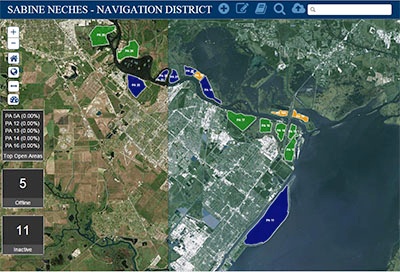This article was written regarding work conducted under legacy company names: Continental Mapping, GISinc, or TSG Solutions. These three companies merged in January 2021 to form a new geospatial leader Axim Geospatial.
The Sabine Neches Navigation District (SNND) is responsible for maintaining the Sabine-Neches Waterway and promoting commercial activity for Southeast Texas as well as the continental United States. SNND staff has the responsibility of coordinating and supervising all dredging operations within the navigation district. In the Summer of 2014, Congress Approved a 26-mile deepening project for the SNND. This project calls for the channel to be deepened by 8 feet allowing modern ships to navigate the waterway. The SNND needed a more efficient way to manage their dredge material placement areas to support this long-term effort. Additionally, the SNND also holds a large collection of digitally scanned documents that pertain to their operations (lease holdings, surveys, property-related documents, dredge permits, etc) dating back to the early 1900's. The SNND refers to these documents routinely and needed a method for rapid discovery and retrieval.
For the initial pilot project, it was decided that the primary platform would need to be versatile enough to run on both PC and Apple computers. A HTML5/JavaScript web application was chosen to address this requirement as well as provide the ability to support mobile devices. The spatial data was loaded into the cloud using ArcGIS.com and employed the ArcGIS API for JavaScript to provide the mapping capability for the front-end website. The use of ArcGIS.com, allows for the SNND staff to view and edit their spatial data remotely without having to maintain an enterprise GIS infrastructure in-house. ArcGIS.com also provides a security infrastructure to allow SNND staff to control access to the web application as well as their spatial data.
The collection of documents was loaded into the Amazon S3 cloud storage and Apache Solr was used to provide the search capability for the documents. Apache Solr is an enterprise search engine that indexes the documents based on user-provided attributes along with information that is automatically extracted from the documents. Apache Solr provides REST web services as a method to search the collection of documents.
When first logging on to the web application, the user is shown a map that shows the current status of the placement areas (e.g. dredge material deposit sites) for the district. The user can use selection tools to pick a particular placement area and get detailed information about its current capacity. The capacity for these areas is regularly updated based on the current dredging operations within the area. This gives SNND staff a real-time picture of which areas are close to reaching full capacity.
The web application allows the SNND staff to update the capacity of the status of a placement area through the web application, automatically updating their back-end GIS data. These editing operations take advantage of time-based layers which allow for a historical record (based on edits) to be kept for each area. The web application also allows the user to search the document collection based on particular attributes or associations to a particular placement area. The user can use the Apache Solr search engine to find a list of pertinent documents and view them within the web application. The documents are viewed via a URL link that points to the Amazon S3 cloud storage. SNND staff can also load individual documents to the Amazon S3 cloud, via the web application, where they are stored and included in the search engine's index for future searches.
The overall benefits to the client were that this application provides them with a real-time common operating picture of the operations in the Sabine-Neches Navigation District. The application allowed their staff to access and maintain their spatial data from a web browser, while efficiently maintaining their spatial data in the cloud. The web application also allows staff to quickly search the collection of documents and view them within one common interface.





